Western Redcedars

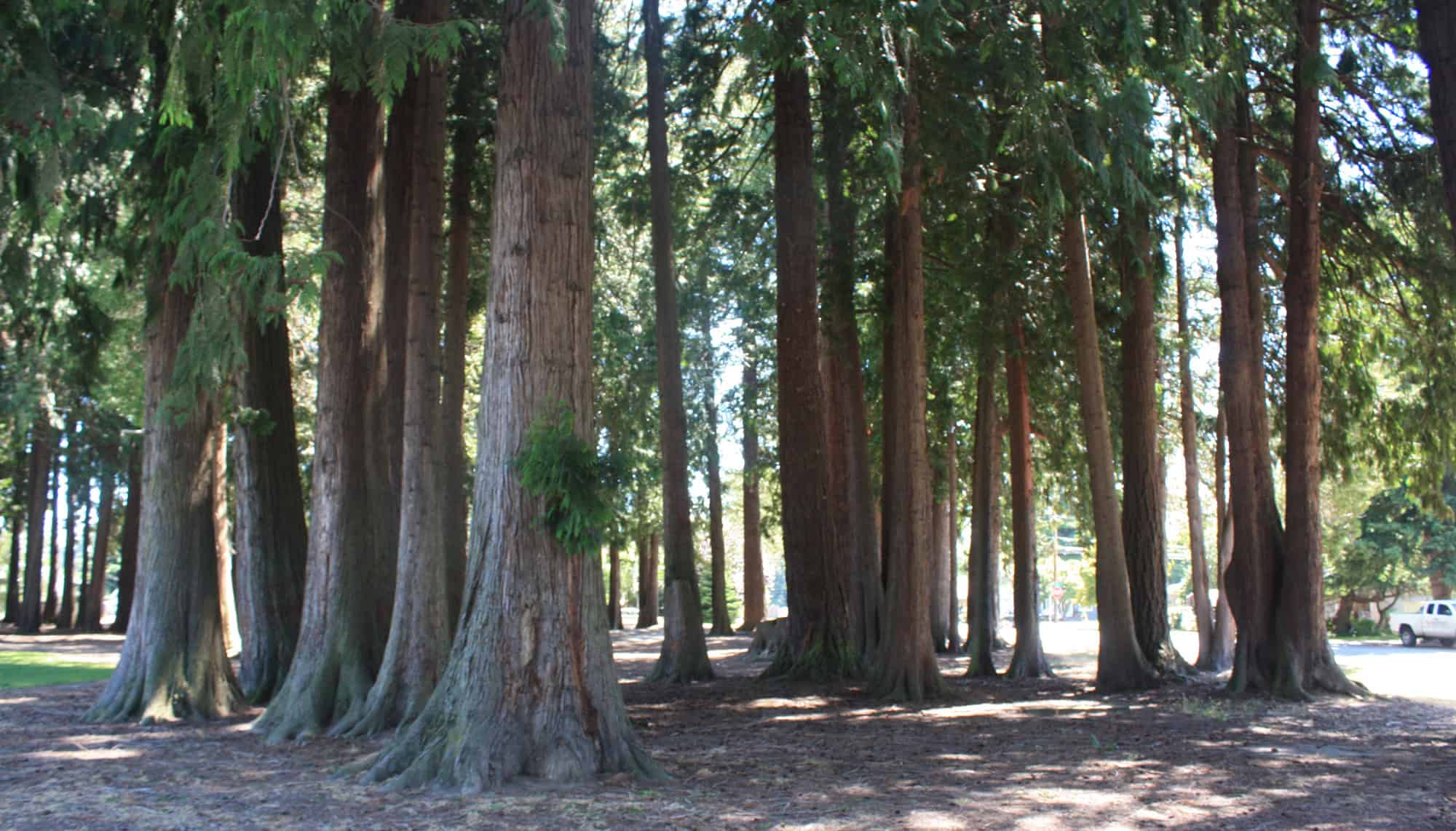
Update on Western Redcedar Dieback in Skagit Valley Cities
Participate as a citizen scientist documenting the beloved western redcedars in your neighborhood.
By: Sonja Nelson, Skagit County WSU Extension Master Gardener
The western redcedar (Thuja plicata) grew at Anacortes, Mount Vernon, and Burlington sites long before city founders officially set the current boundaries in 1879, 1889, and 1902, respectively. This tree species lived amiably with humans at their feet for many years. The trees grew old and tall, thrusting their tips above the human activity below, providing many basic needs for the indigenous communities and later the early European settlers. Like our ancient forebears, modern forest dwellers treasure these trees even though their numbers have dwindled as our cities have grown, and their benefit to humans today is mainly aesthetic. Without the redcedars, our verdant town landscapes of today would suffer significantly from the absence of these green giants in our midst—an almost unthinkable possibility until recently when droughts and heat have taken their toll on Washington's forests.
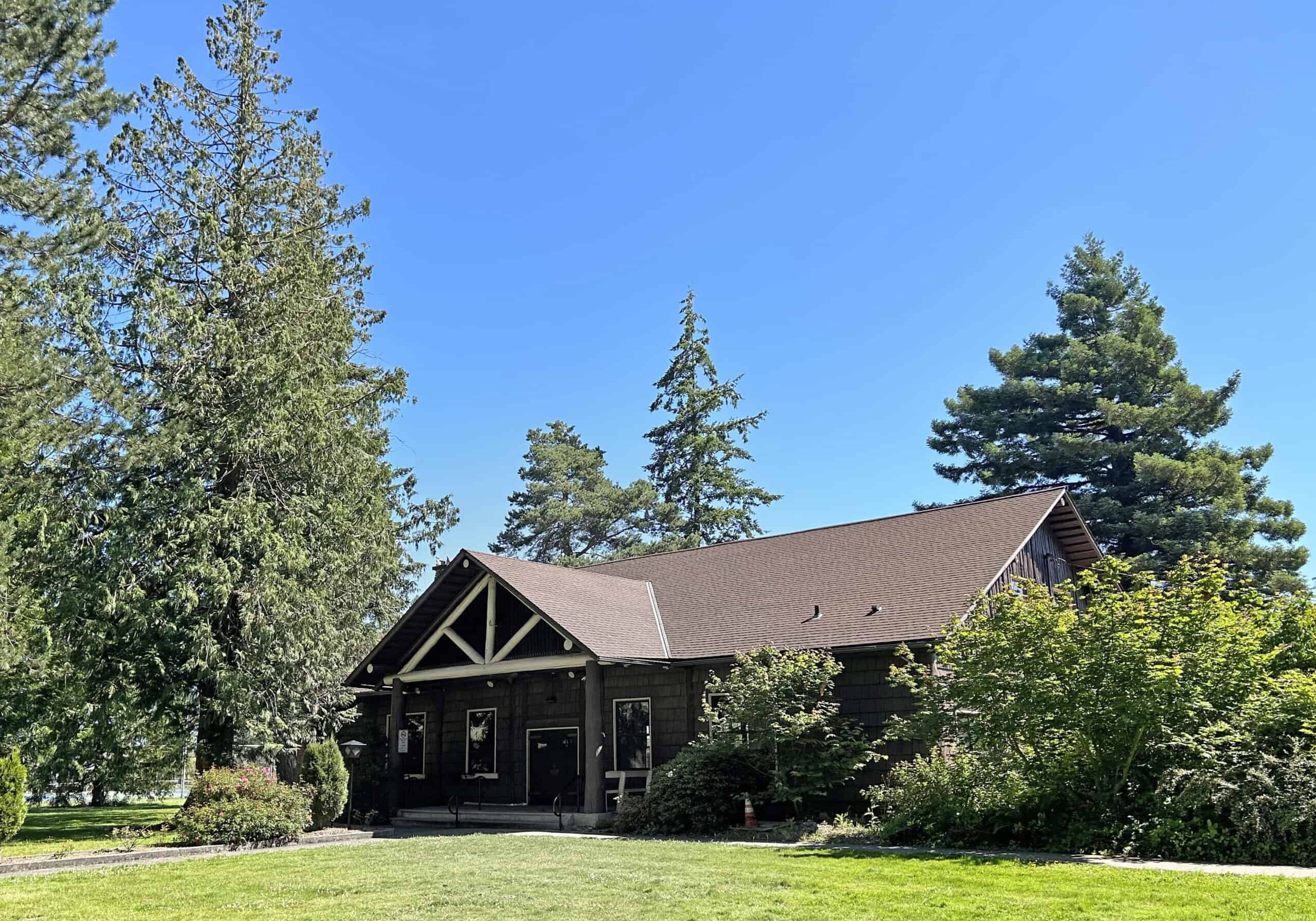
In 2022, the first peer-reviewed research made a definite link between the dieback of western redcedar in the Pacific Northwest and a warmer, drier climate.This research predicts that an upward trend in temperatures will occur. If these higher temperatures do occur, they could well affect the health of our western redcedars in Burlington, Mount Vernon, and Anacortes. as well as other communities in Skagit County. For this post, the author has focused attention on Mount Vernon, Burlington, and Anacortes. See the reference section below for links to data and information about other communities in Skagit County.
Mount Vernon, Burlington, and Anacortes are in the Puget Trough ecoregion, which runs the length of Washington state between the Cascade Mountains in the east, and the Olympic Mountains in the west.
The native coniferous forest of western redcedar, Douglas fir (Pseudotsuga menziesii), and the western hemlock (Tsuga heterophylla) historically have dominated the Puget Trough ecoregion, thriving in a temperate climate of mild, wet winters and warm, dry summers. So far, the three dominant conifers have managed to survive urban sprawl. However, the signs of redcedar dieback manifestation in the Puget Trough have foresters, including forest experts in the cities of Mount Vernon, Burlington, and Anacortes, monitoring the western redcedars for dieback in their jurisdictions. Trees suffering from dieback can exhibit one or all unhealthy characteristics: a thin crown, topkill, a yellowing crown, and branch dieback. Topkill is one symptom of dieback, where the tree's top branches die in response to drought or other stressors, such as excessive heat, leaving behind lifeless branches along the top of the tree that are often visible against the horizon. Other factors contributing to dieback include fungi and insects. Dieback of older needles is often normal and not a symptom.
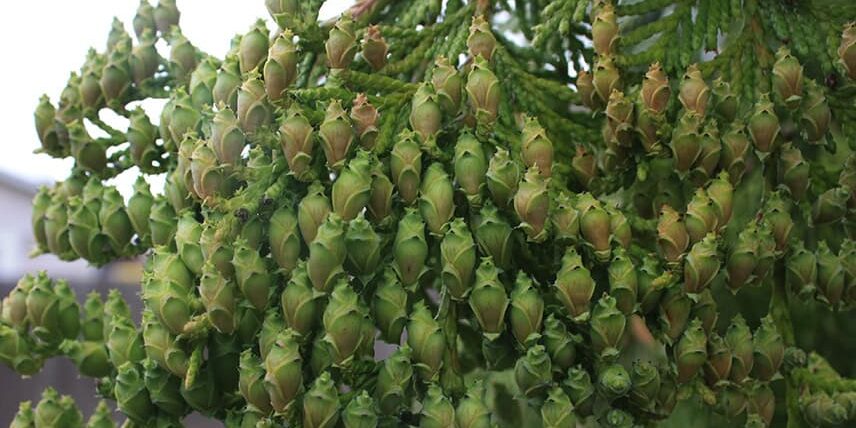
Western Redcedars Populated the Area Prior to Early Settlement
The towns of Mount Vernon and Burlington, rose from a forest floor where old-growth western redcedar, along with spruce, fir, and other timber, grew with little disturbance. Then, in the late 1880s, logging camps were established on either side of the Skagit River, with official boundaries set at the turn of the 20th century. No old-growth western redcedars remain within the cities' limits. Still, the remnants of second-growth redcedars are scattered about the towns on city-owned and privately-owned properties, adorning the towns in year-round green and reminding residents of the towns' early homes in the forest.
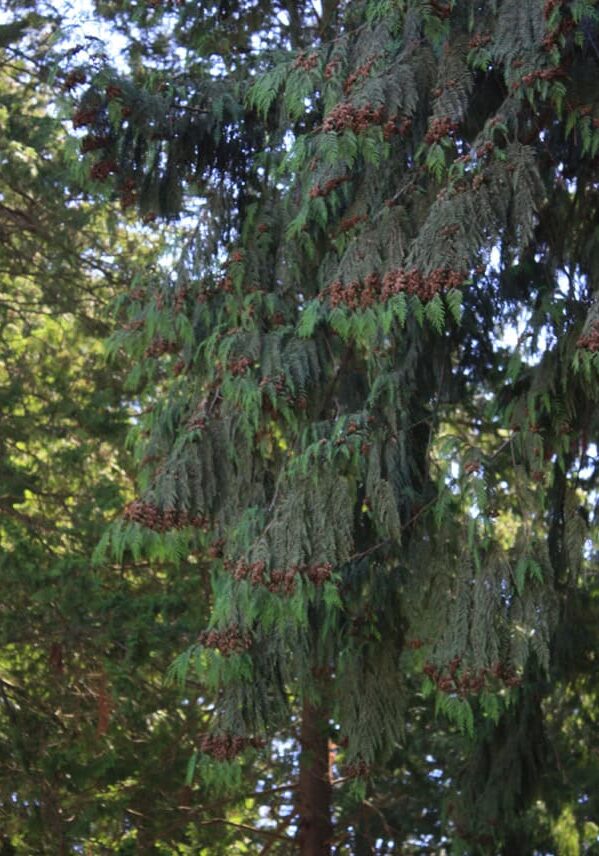
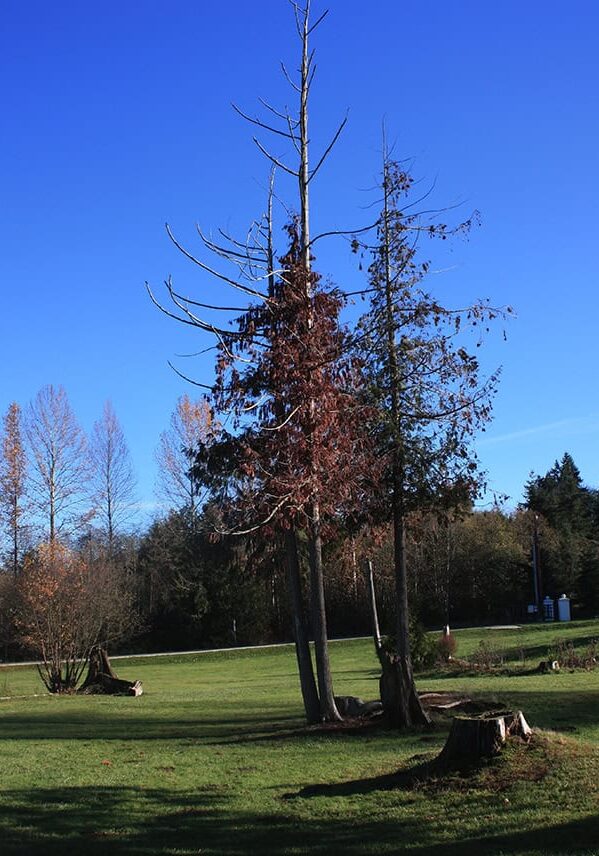
Evidence of Western Redcedar Dieback
To estimate the presence of dieback in western redcedars in Burlington, Mount Vernon, and Anacortes this author visited the cities' parks and used them as samples for the extent of dieback in the two towns.
In Burlington, many of the trees were cut for the development of playgrounds. However, a notable stand of redcedars grows in Maiben Park, also home to the Burlington Community & Senior Center. This grove is a splendid example of second-growth redcedars. Burlington Parks Supervisor Jim Rabenstein observed that dieback is not currently a problem in the park's redcedars. However, in 2019, several Burlington residents reported concern about dieback in town. In response, the parks department hired certified arborists from Urban Forestry Services/Bartlett to assess the redcedars in Maiben Park. Approximately 100 native forest trees were assessed—about 94 were redcedars. The report noted the "exceptional nature of this grove," with redcedars measuring up to 90 inches in diameter at 4.5 feet and in good condition. However, the report stated that drought mitigation planning will be essential in preserving this valuable community resource as long as possible. The report suggested that mulch be added under the trees to mitigate increasing drought stress and heavy foot and bicycle traffic under the trees.
In Mount Vernon, no significant dieback was evident in most of the city's parks. Dieback, however, has occurred among several redcedars at the southern edge of Bakerview Park, most likely due to the compacted turf beneath them. Hillcrest Park, with its numerous redcedars in a natural setting, has yet to show any significant dieback. These second-growth trees are estimated to be at least as old as the park itself where, in March of 2024, the city held a 100th birthday in celebration of the park's founding.
Five years ago, a dieback of the western redcedars occurred at Little Mountain Park, a 522-acre park in southeast Mount Vernon. In response, Sean Corcoran, the Operations Supervisor in the Mount Vernon Parks & Enrichment Services, said that the city requested help from Washington State University Extension, Forestry Division, to assess redcedar dieback in a northeast section of the park. Forest experts determined that root rot (Armillaria) brought on by drought had caused the dieback. Crews removed most of the damaged trees.
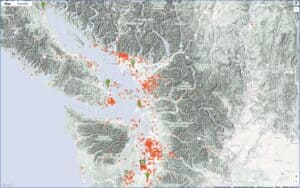
Western redcedar dieback map. Image © iNaturalist
Community Scientists and Western Redcedar Dieback Map
Washington State University, WSU, has invested considerable energy and resources in observing Western Redcedar dieback in Washington state via their WSU Extension Forestry division. Working from the hypothesis that redcedar dieback is a consequence of the region's recent drought, WSU has launched the "Forest Health Watch" to keep track of dieback occurrences. To participate as a "citizen scientist," access their website at https://foresthealth.org/redcedar and report the dieback. Your information will help confront the looming disappearance of these giants in our midst. A detailed map of "citizen scientist" reports is also available. The website also provides multiple links to research on identification, biology, ecology, distribution, ethnobotany, and relevant pests and diseases.
The best action today's gardeners and homeowners can take to prevent redcedar dieback is to keep the soil around their trees weed-free and mulched and to discourage heavy foot traffic. Learn more about how to help your trees beat the summer heat.
REFERENCES AND RESOURCES:
Corcoran, S. Operations Supervisor, Mount Vernon Parks & Enrichment Services. Personal communication 6-11-23.
Forest Health Watch. https://foresthealth.org/redcedar
Gilles, N. New study sounds alarm, provides hope for western redcedar. Oregon Capital Chronicle. March 24, 2023. https://oregoncapitalchronicle.com/2023/03/24/new-study-sounds-alarm-provides-hope-for-western-red-cedars/
WSU Extension, 2018. Forester Notes-Western Redcedar, Washington State University, North Puget Sound Extension Forestry Newsletter, Volume 11, Number 2, July 2018
Puget Trough Ecoregion, 2023. Retrieved from: http://www.landscope.org/washington/natural_geography/ecoregions/puget_trough
Rabenstein, J. Supervisor, Burlington Parks Personal communication 6-11-23.
Reed, W. High and Dry for a NW Icon. Washington State Magazine, Fall 2023. Retrieved from: https://magazine.wsu.edu/2023/07/31/high-and-dry-for-a-nw-icon/

Sonja Nelson
ABOUT THE AUTHOR:
Sonja Nelson is a Skagit County WSU Extension Master Gardener, Class of 2009.
Questions about home gardening or becoming a master gardener may be directed to: Skagit County WSU Extension Office, 11768 Westar Lane, Suite A, Burlington, WA 98233; by phone: 360-428-4270; or via the website: www.skagit.wsu.edu/mg

Mark your calendar for these upcoming master gardener events:
Skagit County Fair
Thursday ~ Sunday, August 8-11, 2024
Skagit County Fairgrounds
Building D
(map)
Visit our booth, see our displays, and talk with master gardeners about how to make your garden beautiful and productive.
Know & Grow Lecture Series
Season Extenders
Presented by Hallie Kintner
Tuesday, August 20, 2024 ~ 1 p.m.
Free Admission
NWREC Sakuma Auditorium
16650 State Route 536, Mount Vernon
A Second Act for Your Square 1-Gallon Pots at the Discovery Garden!
Bring your leftover square 1-gallon pots to the Discovery Garden (16650 State Route 536, Mount Vernon). The bin for recycling the square 1-gal pots is located in the parking lot, just north (to the right) of the main entrance.
We only need square 1-gallon pots like the ones pictured below (bottom right). The recycling bin will be available now through fall. Simply put your pots into the bin, and we take care of the rest!

The final tag “Learn more about how to help your trees beat the summer heat” includes this information: “Water. Long, irregularly timed waterings around the base and drip line of a tree is regarded as the best method to encourage deep root growth and provide sufficient water to the root zone.” Which mulching will help retain.
Thanks Sonja.
Thanks Virgene– I’m starting this around my yard today! I love my trees.